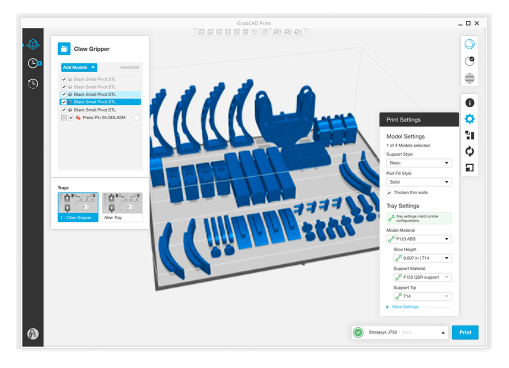Custom 3D Printed Guides Reduce Surgery by up to Three Hours
In the practice of craniomaxillofacial tumor surgery, precision is key. This specialized field, dealing with tumors in the head, face, jaws, and neck, has its own set of challenges due to the complex anatomy and the critical functions of these areas. Each year, thousands of people undergo these surgeries, where millimeters can make the difference between success and significant complications. Essential tools in these procedures are cutting guides, which direct surgeons to make precise incisions and bone alterations. Traditionally made by hand, these guides have been prone to inaccuracies. However, with the introduction of 3D printing, there’s been a notable leap in precision, allowing for custom-fit guides based on individual patient scans.
The University Hospital Birmingham (UHB) in the UK has adopted 3D printed tailored surgical guides to transform these high-stakes operations. By integrating Stratasys’ J5 MediJet 3D printer into its surgical processes, the hospital is pioneering the use of 3D printed cutting guides in craniomaxillofacial surgeries. These custom-made guides were developed with Stratasys to fit each patient’s body perfectly, improving precision and greatly reducing surgery times by up to three hours.

University Hospital Birmingham is improving patient outcomes and reducing surgery times with the integration of tailored, 3D printed surgical guides. Image courtesy of Stratasys.
Streamlined operations
Collaborators at UHB and Stratasys have developed highly accurate surgical guides from patient scans, achieving a resolution of 150 microns. These guides are crafted using the biocompatible PolyJet material Biocompatible Clear MED610, a clear and strong resin designed for medical and dental applications. This material is specially designed for safe interaction with skin and short-term contact with internal tissues, which is crucial for surgical procedures.
“In addition to saving up to three hours of surgery time, 3D printing also enables much better surgical planning,” says Stefan Edmondson, a Consultant Clinical Scientist of Reconstructive Science at the UHB. “Using patient scans, the team is able to create 3D visualizations based on the distinct anatomy of each patient and then leverage 3D printing technology to produce both anatomical models and personalized surgical cutting guides ahead of the actual operation. This capability means we can not only accurately predict the surgery before it’s done but that we have the tools to ensure that the meticulous pre-surgical planning can be executed with the utmost precision. The surgical team is also much better prepared, and the patient is far more at ease, as we can talk through the process and expected outcomes prior to going into the operating theater.”
According to the UHB, in this surgical process, surgeons remove a piece of the patient’s fibula (the lower leg bone) and reshape it for use in the head or neck. This is known as bone grafting and helps fix bone defects. The key challenge is to accurately shape the fibula to fit the specific area’s shape and size while keeping the transplanted bone alive (and functional). 3D printing helps by making accurate surgical guides from patient scans, allowing for more precise shaping of the bone. This micron-level accuracy of these guides is crucial for a good fit and minimizing the risk of rejection and discomfort for the patient, and it’s a big improvement over older, less precise methods.
Supporting this application is Stratasys’ GrabCAD Print Software, which further streamlines the surgical preparation process. The hospital’s years-long experience with Stratasys 3D printers and technologies led to the acquisition of the brand’s multi-material, full-color J5 MediJet 3D printer. Between the hardware and software, the hospital’s surgical capabilities are propelled forward.
Cutting edge care
The implications of this surgical application extend beyond UHB. Other cases include reconstructive surgeries following tumor removal, where patient-specific guides have significantly enhanced the precision of both tumor excision and facial reconstruction. In facial allotransplantation, 3D printed models and guides have been pivotal for successful tissue alignment and integration. Moreover, in cases involving tumor removal and bone reconstruction in the oral and maxillofacial region, these tailored guides have improved surgical accuracy, ensuring better alignment and fit for bone grafts. This technology not only facilitates complex surgical procedures but also contributes to improved patient outcomes, demonstrating a significant evolution in surgical practices.
Overall, integrating 3D printing technology in medical surgery represents a significant leap forward in patient care. With its ability to produce highly accurate, tailor-made surgical guides and models, this technology reduces operation times, improves surgical outcomes, and revolutionizes medical training and planning processes.
Subscribe to Our Email Newsletter
Stay up-to-date on all the latest news from the 3D printing industry and receive information and offers from third party vendors.
Print Services
You May Also Like
New Business: Temporary, Migratory, & Modular 3D Printed Architecture
If we look at potentially emerging 3D printing businesses, then architecture has not been fully explored. Yes, there is a lot of house 3D printing going on worldwide. From deployable...
3D Printing News Briefs, April 19, 2025: Material Extrusion Standard, Metal Powder, & More
In today’s 3D Printing News Briefs, we’re covering a proposed standard for material extrusion, before moving on to business and metal powder. We’ll end with a commercial store’s robotic 3D...
Japan Unveils World’s First 3D Printed Train Station
Japan is now home to what we believe is the world’s first train station built with 3D printing technology. Located in Arida City, just south of Osaka, the new Hatsushima...
restor3d Raises $38M to Expand 3D Printed Orthopedic Implants
Backed by $38 million in new funding, restor3d is pushing ahead with the launch of four personalized implant lines, set to roll out in 2025 and 2026. This latest venture...


























